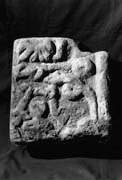Select a site alphabetically from the choices shown in the box below. Alternatively, browse sculptural examples using the Forward/Back buttons.
Chapters for this volume, along with copies of original in-text images, are available here.
Object type: Shaft fragment [1]
Measurements: H. 31.5 cm (12.4 in) W. 28.5 cm (11.2 in) D. 17 cm (6.7 in)
Stone type: Exactly as North Otterington 1 (St Michael)
Plate numbers in printed volume: Ills. 692–3
Corpus volume reference: Vol 6 p. 185-186
(There may be more views or larger images available for this item. Click on the thumbnail image to view.)
A (broad) : The left-hand side is dressed off. On the right is a prominent but flat broad edge moulding. Within the panel at the top on the left is a feature resembling a bird's tail, or six-lobed leaf. To its right are remains of a vertical strand, below which is the upper part of a frontal human figure, surrounded by discrete snakes, each with a single twist. This face is very worn.
B (narrow) : The edge moulding on the left is broad and flat. Within the panel is a zig-zag broad modelled strand which forms a crude plant-scroll with a narrow band for a ridged node. The triangle above this may have been a splayed leaf. On the right is a scrolled shootlet.
C (broad) and D (narrow) : Lost.
Like no. 1, the carving is fairly crude and the design disorganised, and also like its companion it has Anglian survival in its plant-scroll, however rough the cutting. The imagery of a human amid small snakes is repeated; see Masham 3 (Ills. 694–7). It would be rash to interpret this as the Germanic hero Gunnar in the snake pit from the Sigurðr myth, since the human is neither bound nor musically active. Perhaps it should be seen in the context of some Cumbrian monuments which display human conflict with great serpents: for example, Gosforth 5 and Great Clifton 1 (Bailey and Cramp 1988, 106–8, 110–11, ills. 323, 327, 329, 335, 336). For the North Otterington pieces it would be prudent to follow Bailey's suggestion of a Christian Hell, where 'naked men strive among the serpents' (ibid., 111; Krapp 1931, 140), though it would hardly be complimentary iconography for the deceased.



